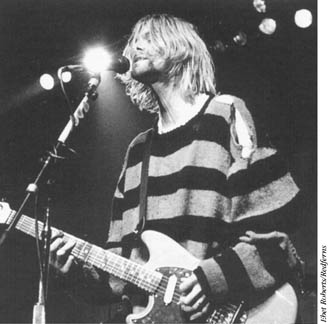
Figure The leading light of Nirvana and grunge music, Kurt Cobain’s success merely seemed to add to his distress.
During the 1990s, no rock band was more important in America than Nirvana. Led by brilliant but disturbed singer-songwriter-guitarist Kurt Cobain, the trio led the blazing Seattle scene in the early years of the decade. Even after Cobain’s tragic death in 1994, Nirvana’s raw, raging sound remained profoundly influential—affecting not only countless American groups but bands all over the world, from England’s Bush to Australia’s Silverchair.
Nirvana’s roots lay southwest of Seattle in the economically depressed coast town of Aberdeen, Washington. Born there on February 20, 1967, to parents who divorced when he was eight, Cobain grew up troubled and troublesome, involved in petty crime until he immersed himself in music. First came an enduring love for the pop music of the BEATLES and ABBA, then for the hard rock and heavy metal of LED ZEPPELIN and Black Sabbath, and finally for the work of punk bands like Black Flag, Flipper, and Aberdeen’s own Melvins. Cobain learned electric guitar and, with bass player Chris Novoselic (b. Krist Anthony Novoselic on May 10, 1965, in Compton, California), and drummer Chad Channing (b. January 31, 1967, in Santa Rosa, California), he formed Nirvana in 1987.
The next year, Seattle’s independent label Sub Pop signed Nirvana. From the first single, “Love Buzz,” and the album Bleach, in 1989, the group displayed the downbeat yet uniquely inviting sound that would eventually make it famous. Cobain’s introspective compositions, crafty arrangements, howling vocals, and ferocious guitar reinvented punk, infusing it with his pop and poetic sensibilities. Songs such as “Smells Like Teen Spirit”—the group’s 1991 breakthrough single on the new label Geffen—provided uncompromising yet irresistible thrill rides, soaring and dipping, stopping and starting. The Geffen debut album Nevermind, with Channing’s replacement, Dave Grohl (b. January 14, 1969, in Warren, Ohio), sold spectacularly well.
The band’s fame continued despite 1992’s inconsistent collection of odds and ends, Incesticide. The 1993 album In Utero was masterful—debuting at No. 1 and containing the hits “Heart-Shaped Box” and “All Apologies.” Unplugged in New York, in 1994, was an outstanding, almost-acoustic concert taped for MTV—with a riveting version of David BOWIE’S “The Man Who Sold the World.” However, the anguish that inspired Cobain’s art increasingly plagued him. Despite success, which he could not come to terms with, marriage to Courtney Love (actress and singer for the abrasive band Hole) in 1992, and the birth of a daughter, he increasingly suffered from depression and heroin addiction. On April 8, 1994, he was found dead in his Seattle home, apparently the victim of a suicide three days before. Although Cobain is gone, the sound of Nirvana—honest, piercing, and magnificent—lives on.

Figure The leading light of Nirvana and grunge music, Kurt Cobain’s success merely seemed to add to his distress.
Terry Atkinson
SEE ALSO:
GRUNGE; HEAVY METAL; ROCK MUSIC.
FURTHER READING
Dome, Malcolm, and Mick Wall. Nirvana: The Legacy (London: Omnibus Press, 1996);
Thompson, D. Never Fade Away: The Kurt Cobain Story (New York: St. Martin’s Press, 1994).
SUGGESTED LISTENING
In Utero; MTV Unplugged in New York; Nevermind.